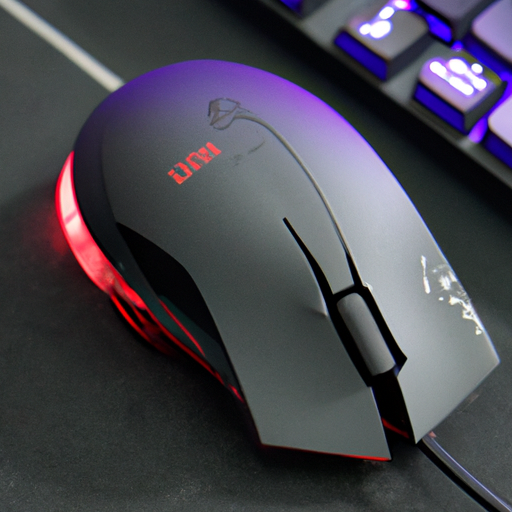How Do I Choose A Good Gaming Mouse? 10 Points to Ponder
How Do I Choose A Good Gaming Mouse: Introduction
Are you an avid gamer looking to upgrade your gaming equipment? If so, you may be asking, “How Do I Choose A Good Gaming Mouse?” Choosing the right gaming mouse is crucial to enhance your gaming experience. With the vast array of options available in the market, selecting the perfect gaming mouse can be a daunting task.
Fear not, as this article will guide you through the essential factors to consider when choosing a good gaming mouse that suits your needs. From ergonomic design and customizable buttons to DPI settings and wired vs. wireless options, we’ve got you covered. So, let’s dive into the world of gaming mice and find the perfect fit for you!
Choosing a gaming mouse that suits your needs and preferences can greatly enhance your gaming experience. With so many options available in the market, it can be overwhelming to make a decision. However, by considering various factors such as your playing style, the sensor type, DPI and polling rate, programmable buttons, ergonomics, connectivity options, build quality and durability, customization features, reading reviews, and setting a budget, you can narrow down your choices and find the perfect gaming mouse for you.
How Do I Choose A Good Gaming Mouse: Consider Your Playing Style
When choosing a gaming mouse, it’s important to first determine your gaming genre. Are you into first-person shooters (FPS), multiplayer online battle arenas (MOBA), real-time strategy (RTS), or casual gaming? Each genre requires different types of mouse movements, such as quick and precise aiming in FPS games or swift and accurate clicks in MOBAs. Consider your playing style and the specific requirements of your favorite games to find a mouse that can cater to your needs.
Another aspect to consider is your grip style. Different players have different ways of gripping the mouse, such as palm grip, claw grip, or fingertip grip. The grip style affects how you hold and maneuver the mouse, and certain mice are designed to accommodate specific grip styles. Understanding your grip style can help you choose a mouse that provides the best comfort and control.
How Do I Choose A Good Gaming Mouse: Know the Sensor Type
The sensor of a gaming mouse plays a crucial role in tracking the movement and translating it into on-screen actions. There are three main types of gaming mouse sensors to consider: optical, laser, and infrared sensors.
Optical sensors use an LED light to track the surface beneath the mouse. They are generally more accurate and responsive, making them ideal for gamers who require precise tracking and quick movements. They also tend to work well on a variety of surfaces, including cloth and hard mouse pads.
Laser sensors, on the other hand, use a laser beam to track the surface. They offer high tracking resolution, making them suitable for gamers who need fast and precise movements. However, laser sensors may struggle on certain surfaces, such as glossy or reflective ones. They also tend to have slight acceleration, which may affect accuracy in some cases.
Infrared sensors are a newer technology that combines the best features of optical and laser sensors. They provide accurate tracking, improved cursor precision, and work well on various surfaces. Infrared sensors are often found in high-end gaming mice and offer an excellent balance between accuracy and versatility.
How Do I Choose A Good Gaming Mouse: Consider DPI and Polling Rate
DPI, or Dots Per Inch, refers to the sensitivity of the mouse. A higher DPI means the cursor will move more quickly across the screen, while a lower DPI will result in slower cursor movement. The DPI setting can usually be adjusted on the mouse itself or through software.
When choosing a gaming mouse, consider the DPI range it offers and whether it can be customized to suit your preferences. Some gamers may prefer a higher DPI for faster movements, while others may prefer a lower DPI for improved accuracy during precise aiming.
Polling rate refers to how often the mouse reports its position to the computer. It is measured in Hertz (Hz) and indicates the responsiveness and smoothness of the cursor movement. A higher polling rate means the mouse reports its position more frequently, resulting in smoother cursor movement. Most gaming mice offer polling rates ranging from 125Hz to 1000Hz, with higher rates being more desirable for gamers.
Understanding DPI and polling rate can help you choose a mouse that provides the right balance of sensitivity and responsiveness for your gaming needs.

Look for Programmable Buttons
Programmable buttons are a common feature in gaming mice that allow you to assign various functions or macros to specific buttons. This can be particularly useful for gamers who want quick access to certain commands or macros without having to reach for the keyboard.
When choosing a gaming mouse, consider the number of programmable buttons you need. Some mice offer a few extra buttons, while others have an extensive array of programmable options. Think about the commands or macros you frequently use in your games and determine how many buttons would be sufficient for your needs.
In addition to the number of buttons, consider their placement on the mouse. Ideally, the buttons should be easily accessible and within comfortable reach of your thumb or fingers. Some mice have side buttons, while others have buttons placed near the primary click buttons. Choose a button layout that aligns with your preferences and playing style.
How Do I Choose A Good Gaming Mouse: Take Ergonomics into Account
Ergonomics play a vital role in ensuring a comfortable gaming experience. Choosing a mouse that fits your hand size and grip style can help prevent fatigue and improve overall control.
When selecting a gaming mouse, consider the size and shape of your hand. Mice come in various sizes, from small to large, and finding one that matches your hand size can greatly enhance comfort. Additionally, consider the weight of the mouse. Some gamers prefer a lighter mouse for swift movements, while others prefer a heavier mouse for added stability. Experiment with different weights to find what works best for you.
The grip of the mouse is equally important. Look for a mouse that offers a comfortable grip for your preferred style, whether it’s palm grip, claw grip, or fingertip grip. Some mice feature textured surfaces or rubberized grips to provide added comfort and prevent slippage during intense gaming sessions. Make sure to test different mice and grip them to get a sense of how they feel in your hand.

Consider Connectivity Options
Gaming mice are available in both wired and wireless options, each with its own advantages and considerations.
Wired gaming mice connect directly to the computer via a USB or PS/2 port. They offer a reliable and stable connection, with virtually no input lag. Wired mice also do not require batteries, eliminating the need for regular charging or battery replacements. However, the wire can restrict movement and may be less convenient for gamers who prefer a clutter-free gaming setup.
Wireless gaming mice, on the other hand, provide more freedom of movement and reduce cable clutter on your desk. They often connect to the computer via a wireless dongle or Bluetooth, allowing you to play games without being tethered to your device. However, wireless mice typically require batteries and may experience occasional input lag or signal interference. It’s important to consider the battery life and connectivity stability when choosing a wireless gaming mouse.
Evaluate your gaming setup and preferences to determine whether a wired or wireless gaming mouse is the better option for you.
Evaluate Build Quality and Durability
The build quality and durability of a gaming mouse are crucial factors to consider, as they can greatly impact the longevity and reliability of the device.
Look for gaming mice that are made of durable materials, such as aluminum or high-quality plastic. Mice with reinforced cables can also withstand frequent movements and reduce the risk of cable fraying. Furthermore, pay attention to the overall construction of the mouse. It should feel solid and well-built, without any loose or flimsy parts.
To assess the durability of a gaming mouse, check for reviews or testimonials from other users who have used the mouse for an extended period. Look for information regarding the mouse’s longevity and whether it has any known issues or weaknesses.

Check for Customization Features
Customization features can add a personalized touch to your gaming mouse and make it uniquely yours. While these features may not directly impact performance, they can enhance the aesthetics and overall experience of using the mouse.
One common customization feature is adjustable weights. Some gaming mice come with removable weights that allow you to adjust the overall weight of the mouse to your preference. This can be useful for finding the optimal balance between stability and agility.
RGB lighting is another popular customization feature found in many gaming mice. These mice feature LED lights that can be customized to display various colors and lighting patterns. RGB lighting can add a visually appealing element to your gaming setup and create a unique atmosphere while gaming.
Software customization is also worth considering. Many gaming mice come with software that allows you to customize button assignments, DPI settings, polling rates, lighting effects, and more. This software gives you full control over the mouse’s settings, allowing you to fine-tune it according to your specific needs.
Read Reviews and Compare Options
Before making a final decision, it’s essential to read reviews and compare different gaming mouse options. Researching the top gaming mouse brands can provide insights into their reputation, customer service, and product quality.
Customer reviews and opinions are invaluable resources when deciding on a gaming mouse. Look for feedback from individuals who have used the mouse for gaming and pay attention to their experiences with its performance, comfort, durability, and customization features. Reading a variety of reviews can help you uncover both the strengths and weaknesses of different mice, assisting you in making an informed decision.
While reviews provide valuable insights, it’s equally important to compare the features and prices of different gaming mice. Consider the specific requirements of your gaming genre, the functionality you desire, and the budget you have in mind. By comparing multiple options, you can identify the gaming mouse that offers the best combination of features, performance, and value for your needs.

How Do I Choose A Good Gaming Mouse: Set a Budget
Setting a budget is an essential step in choosing a gaming mouse. Gaming mice are available in a wide price range, and it’s crucial to determine your price range before exploring your options.
Consider how much you are willing to spend and balance it with the features and performance you seek. While more expensive gaming mice may offer advanced customization features and high-end sensors, there are often budget-friendly options that provide excellent performance without breaking the bank.
Finding the perfect gaming mouse for your needs is not solely dependent on price; it’s about finding the right balance between features, performance, and affordability.
How Do I Choose A Good Gaming Mouse: In A Nutshell
Understanding Your Needs and Playing Style
The first step in choosing a good gaming mouse is understanding your own playing style and needs. Are you into fast-paced FPS games, or do you prefer strategy-based games? Your genre of choice can significantly influence the type of mouse that will suit you best.
Sensor Type: Optical vs. Laser
The sensor type, whether optical or laser, is a critical aspect to consider. Optical sensors are generally considered more accurate but may not work on all surfaces. Laser sensors can work on more types of surfaces but might offer slightly less accuracy. Your choice will depend on your specific needs and the surface you intend to use.
The Importance of DPI and Polling Rate
DPI (Dots Per Inch) and polling rate are technical specifications that impact cursor speed and responsiveness. A higher DPI will give you quicker movement, while a higher polling rate ensures that the mouse’s position is reported to your computer more frequently. Depending on your game type, you may need a higher or lower setting for each.
Programmable Buttons for Custom Gameplay
If customization is essential for you, look for a mouse with programmable buttons. These can be mapped to specific actions in-game, offering you a unique advantage and the opportunity to create a more tailored gaming experience.
Ergonomics and Comfort
Comfort should never be compromised. Ergonomics is vital, especially for extended gaming sessions. Look for a mouse that fits well in your hand and doesn’t cause strain over time. Some gaming mice even offer customizable weights and grips.
Wired or Wireless: Connectivity Options
The age-old debate between wired and wireless options still exists. Wired mice offer quicker response times, while wireless mice offer greater freedom of movement. Your choice here would depend on your specific gaming style and setup constraints.
Build Quality and Durability
A good gaming mouse should be built to last. Opt for mice that have high-quality materials and are known for their durability. The last thing you want is to replace your mouse frequently, which can become an expensive habit.
Customization Features and Software
Some gaming mice come with software that allows further customization, from RGB lighting to setting up complex action macros. While not a necessity, it can add a fun, personal touch to your gaming setup.
Research and Reviews
Always do your homework. Reading reviews from other gamers can provide valuable insights into how a mouse performs in real-world conditions. If possible, visit a store to get a hands-on feel of different models before making your decision.
Budget: Getting Value for Your Money
Lastly, setting a budget is essential. Gaming mice can range from budget-friendly to extremely expensive. Knowing how much you’re willing to spend can narrow down your options and help you focus on what truly matters to you.
Final Words
In summary, selecting the ideal gaming mouse is a nuanced process that involves a multitude of factors. By carefully weighing each element—such as playing style, technical specs, ergonomics, and budget—you can make an informed decision that enhances both your gaming experience and your competitive edge. Happy gaming!




